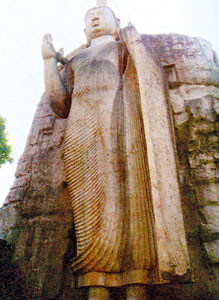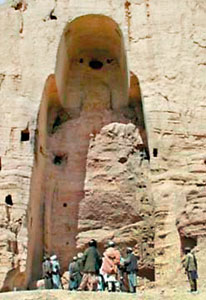Around 30,000 Greek bhikkhus had arrived in Anuradhapura from the monasteries of Alasanda (the city of the Yonas, Alexandria in present Afghanistan) according to Geiger’s Mahavamsa (chapter XX1X (39)) to participate in the inauguration of the construction of the Mahaseya (Ruvanveliseya.) The Greek bhikkhus led by Yonamahadharmarakkhita Thera had been part of 96,000 foreign bhikkhus who had arrived from several ancient Indian states and Persia for the ceremonial event.
Evidently, Buddhism had been the vibrant force behind Sri Lanka’s interaction with foreign countries in early history and as studies reveal, Bactrian Greek (Indo-Greek) influence in days gone by has had a lasting impact on Sri Lanka.
Professor A.D.T.E. Perera of the Department of Philosophy, University of Mexico and former Editor of the Buddhist Encyclopaedia writing a scholarly essay on “Colossal Buddha Images of Ancient Sri Lanka” had stated that Bactrian Greek art influenced the sculpture of colossal images of the Buddha in Sri Lanka.
Bactrians, on leaving NW India spread out from Kabul to Punjab after their defeat by Chandragupta in the Mauryan Period. But having been attracted to the new Buddhist doctrine while they were in NW India, they, after their shift, sculpted imposing images of the Buddha in standing position in the Bamiyan Region in Afghanistan which were destroyed by the Taliban a few years ago.
These images Professor Perera states led to the ideas pertaining to the turning out of colossal statues of the Buddha in Sri Lanka. The first attempt was the carving of the Avukana Buddha Image in the ancient Rajarata.
 |
 |
| The Avukana Buddha statue and inset, the Bamiyan Buddha statue |
Bactrian images of the Buddha in the Bamiyan region in Afghanistan Prof. Perera traces may have been a veritable source of inspiration to the early artists who crossed the Kabul valley which linked the Southern branch of the Great Northern Highway referred to in the early Buddhist and Indian texts as “Uttarapada” – the trade route of the then known world which bridged the East and the West on commercial, political and cultural levels.
Traders, pilgrims and even men of learning had crossed the region in search of various fortunes. Prof. Perera says that Sri Lankans too may have had links with this ancient world known as Gandhara which covered a vast area extending beyond NW India and it was such religio-cultural-trade contacts that had prevailed between Sri Lanka and the Gandhara region that may have led to the invitation to be extended by King Dutugamunu to the Greek bhikkhus to participate in the inauguration of the construction of the Mahaseya.
According to the essay, archaeological researchers and art historians distinguish a close similarity between the Avukana image with that of the Bamiyan. The Bamiyan region had been referred to in early Buddhist Prakrit as Vokkana, Avakana or Vakana. The name Avukana it is surmised had been derived for the colossal statue in Sri Lanka from the name of the Bamiyan region.
Bactrian Greek Buddhist artists had been very active in the 2nd or the 3rd centuries BC in the Bamiyan region in West Asia and the Buddha images silhouetted against the vast sandy valley bearing a calm and serene composure may have been an awe-inspiring vision for the travellers who passed by. The images had stood at 112 and 172 feet respectively and were housed within their own chapels.
The 43 feet tall Avukana Buddha image depicts the abhaya mudra with the right hand raised towards the right shoulder indicating that the devotee is protected from all fears (bhaya.) The raised left hand is touching the left shoulder with the palm turning towards the Buddha – a gesture seeking the Buddha to release the devotee from sentient bondage (samsara). The back of the image is not separated from the rock boulder out of which the figure is hewn.
Professor Perera however states that the Maligavila Buddha image, 52 feet in height with its lotus pedestal, was considered as one of the world’s tallest standing images sculpted in ancient times. It was discovered in southern Sri Lanka fallen with broken limbs and beaten by the elements. This may have been due to the fact that the image carved on limestone was sculpted on the round. It may have fallen unlike other images since it was separated from a living rock. The third colossal Buddha image which Professor Perera had discussed was found at Sasseruva close to Anuradhapura. Sculpted in high relief with the back cleaving to the living rock boulder, the image was either badly weatherworn when it was found or left unfinished by the sculptor. Although it falls short of the elegance of the Avukana image, it bears the same features with regard to stylistic concepts, the hand posture, the method of wearing the “civara” with the right shoulder kept bare and the drapery delineated by parallel ridges as followed by sculptors of the classical period.
These Buddha images are dated to around the 4th – the 6th centuries in the present era. All colossal Bamiyan statues had been sculpted by those who advocated Mahayana Buddhism and Mahayana Buddhism it is believed had its birth in the Bamiyan part of the Gandhara region. Professor Perera states that the concept of portraying the Buddha in super human qualities – as a saviour of all human and divine beings was followed wherever Mahayana Buddhism spread.
The concept of the bodhisatvas belonging to the Mahayana pantheon eventually had found its way into the ensemble of architectural compositions of colossal sculptures in Sri Lanka. Close to the Maligavila Buddha image, a huge bodhisatva image had been disovered. And in the group of colossal sculptures at Buduruvagala, the primary image of the Buddha is flanked by bodhisatva Avalokitheshvara of the Mahayana pantheon with Goddess Tara. On the other side is the bodhisattva Mahasthamaprapta with his consort Prajna – all referred to as acolytes of Buddha Amitabha who resides in Sukhavati.
The colossal Buddha in parinibbana manca (death bed) sculpted in the Polonnaruwa period does not belong to the Mahayana pantheon. But Professor Perera says that the concept had gained currency even after the fall of Anuradhapura and hence the Polonnaruwa images belonged to the last lap in the classical period of Sinhala art.
The Greeks’ entry to the Buddhist theatre in India could be traced to the invasion of Alexander in 334 BC when he captured some parts of the NW India extending as far as the Indus. With the conquest and setting up of Greek settlements, his Greek garrison and a host of camp-followers had poured into NW India who may have been assimilated into the Indian populace. These Greeks, fascinated by the new Buddhist doctrine introduced about 200 years earlier, had embraced Buddhism. Some had joined the Bhikku Order.
Although Alexander’s rule in India ended with his death 18 months later, Greek influence continued for several more centuries. It is recorded that Emperor Dharmashoka (about 273-232 BC) in the Mauryan Period sent Greek Bhikkhus such as Dharmarakkhita and Mahadharmarakkhita Theros to Syria, Egypt, Macedonia, Cyrene and Epirus as emissaries of Dhamma.
In the pre-Graeco period, the image of the Buddha in India was represented symbolically by His Footprints, a lotus, the Bodhi, the Dharmachakra, the Caitya etc. From the Greek-Indian fusion rose the Graeco-Buddhist art of Gandhara when Greeks contributed to the sculpted work of the Ashoka Pillars and to the commencement of the Mauryan art with Buddha image carved.
In the earliest sculptures excavated in the Gandhara sites, the Greek influence is seen in the representations of the Buddha where the Buddha had been elevated to a God. The Bactrians who had spread out from NW India and Kabul to Punjab and West Asia progressed into portraying the Buddha figure in superhuman qualities which brought about the origins of the titanic image of the Buddha. With the spread of Mahayana the concept too spread.
Besides the colossal images of the Buddha, Greek influence on early literature is discussed by Professor Merlin Peris in his book titled “Mahavamsa Studies Greek myths in Ancient Tradition” where he discloses an element of Greek mythology in certain anecdotes related in the Mahavamsa.
Elaborating on his statement he says that L.S. Perera, A.L. Basham and G. C. Mendis in the “University of Ceylon, History of Ceylon” had commented on the affinities which could be seen in Vijaya-Kuveni affair with that of the Greek adventure of Odysseus with Circe in Homer. Professor Peris says that besides, the Greek myth Jason and Medea is emulated in the killing of the yakshas with Kuveni’s help and the dismissal of her and her children for a royal marriage (men are afraid of enchantresses.)
Greek story motifs Professor Peris says may have found their way into the “Attakatha Mahavamsa” (pre-Mahavamsa literary work) before being incorporated by the Mahavamsa author when he wrote on the reigns of our earliest kings.
Professor Peris sees motifs of the Greek myth of Danae in the episodes of Ummadacitta, certain early heroes and the sacrifice of Viharamahadevi. However, while Professor Peris’ interpretation of incorporation of Greek story motifs in the earliest literary tradition gives food for thought, Greek impact on Sri Lankan religio-culture illustrates the fact that Sri Lanka had been very much in the international whirlpool. |



